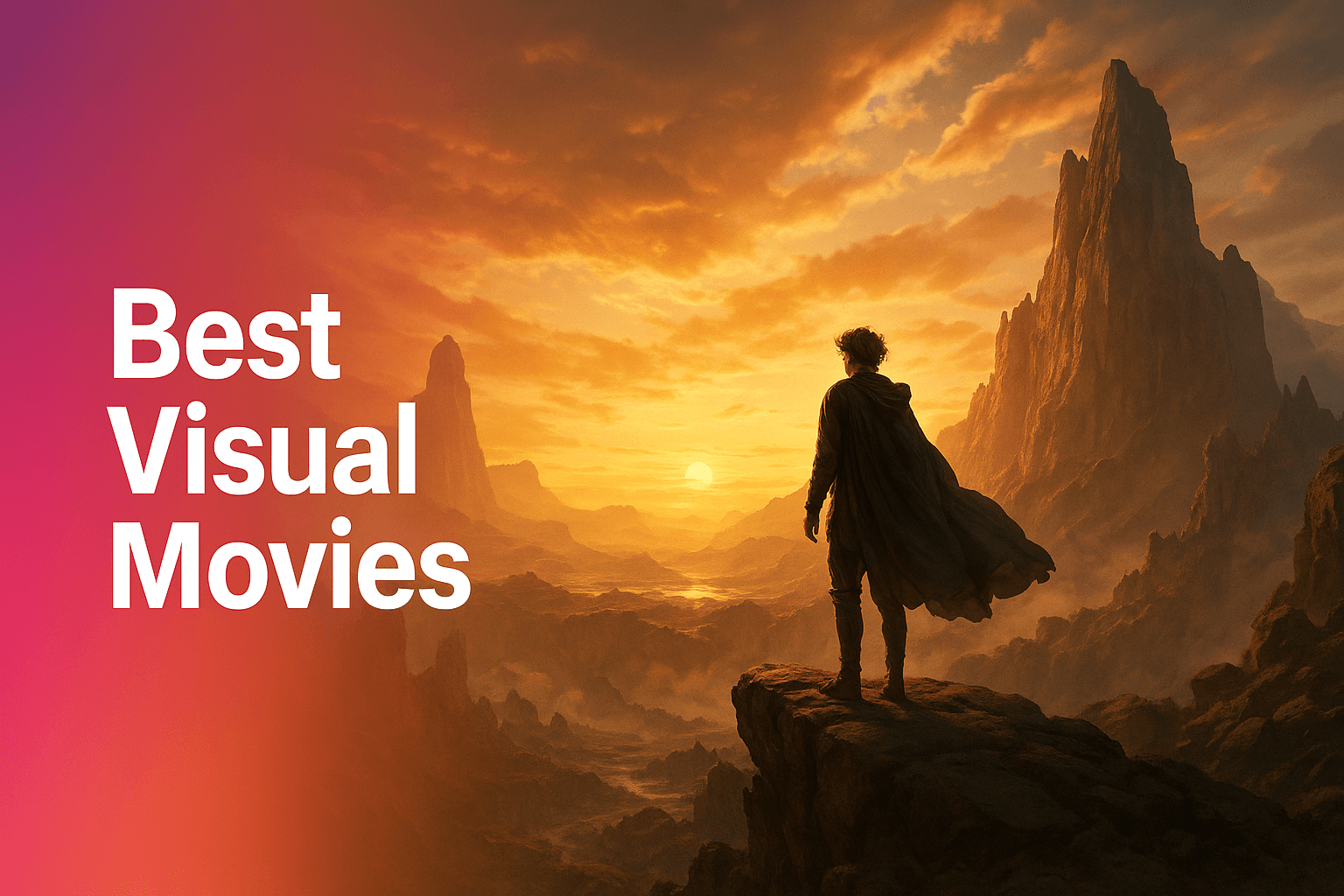Best Visual Movies: A Guide for M&E Industry Leaders

Introduction
As a senior executive in the Media & Entertainment landscape, you operate in a world where visual language dictates market success. The gap between a breakout hit and a forgotten title is often defined by its aesthetic power. Yet, identifying and assembling the elite global talent required to create visually compelling content remains one of the industry’s most persistent and costly challenges, fraught with fragmented data, unverified partners, and inefficient discovery.
This analysis moves beyond a simple list, providing a strategic framework for understanding what constitutes visual excellence and how to systematically find the partners capable of delivering it. The insights here are powered by Vitrina’s global M&E supply chain intelligence platform, which tracks the projects, companies, and professionals behind the world’s most definitive visual works.
Key Takeaways
| Core Challenge | The M&E industry’s fragmented nature makes it difficult to efficiently discover and vet the elite, specialized creative talent required for visually ambitious projects. |
| Strategic Solution | A data-driven approach to partner discovery, using a clear evaluation framework based on cinematography, production design, VFX, and color grading, de-risks production. |
| Vitrina’s Role | Vitrina provides a centralized intelligence platform to identify, profile, and connect with over 3 million creative professionals and 15,000+ service vendors globally. |
The Art of Visual Storytelling: What Defines the Best Visual Movies?
In my analysis of the global content market, the term “visually stunning” is often used but rarely defined with strategic precision. For an M&E leader, a truly exceptional visual movie is not merely one with beautiful pictures; it is a meticulously constructed asset where every frame serves the narrative and enhances commercial appeal. This is achieved through the convergence of four critical domains: cinematography, production design, visual effects (VFX), and color grading.
Cinematography is the language of the camera—its movement, lighting, and composition dictate the audience’s perspective and emotional response. Production design is the discipline of world-building, creating the tangible environment, from sprawling sets to minute props, that lends authenticity to the narrative.
VFX, both practical and digital, expands the realm of possibility, allowing for the creation of worlds and sequences that cannot be captured in-camera. Finally, color grading provides the emotional texture, unifying all visual elements under a cohesive palette.
The best visual movies are those where these four pillars are not just excellent in isolation but are flawlessly integrated, guided by a singular directorial vision. This level of synthesis is the hallmark of high-performing creative teams.
Our Evaluation Framework for Identifying the Best Visual Movies
To move from subjective appreciation to objective analysis, a clear framework is necessary. My methodology for curating this list is based on assessing how each film demonstrates mastery in execution and innovation. The criteria include:
- Technical Innovation: Did the film push the boundaries of existing technology? This could be through pioneering new VFX techniques, camera systems, or post-production workflows that set a new industry standard.
- Cohesive World-Building: How effectively did the production design, costuming, and cinematography work together to create a believable and immersive world? This is crucial for audience engagement, particularly in genre films.
- Narrative Integration: Does the visual style serve a distinct narrative purpose? The most powerful visual films use their aesthetic to deepen character, advance the plot, or explore complex themes, rather than simply providing spectacle. According to the American Society of Cinematographers (ASC), this synthesis of art and story is the ultimate goal of the craft.
- Lasting Industry Influence: Did the film’s visual language inspire or influence subsequent projects? A truly definitive work often creates a new visual shorthand or popularizes a style that is replicated across the industry for years.
Applying this framework allows us to understand not just that a film looks good, but why it succeeds as a piece of visual art and a commercial product. It also highlights the immense challenge of sourcing the right combination of talent and technology—a recurring pain point for producers and studio executives worldwide.
A Curated List of Visually Defining Movies
The following list represents films that not only meet the criteria of our evaluation framework but have also had a measurable impact on the industry. Each is a case study in how visionary leadership and world-class execution can converge to create something enduring.
Blade Runner 2049 (2017)
Helmed by director Denis Villeneuve and cinematographer Roger Deakins, this film is a masterclass in atmospheric world-building. Deakins, who won an Academy Award for his work, used stark, minimalist lighting and a palette of muted oranges and blues to create a dystopian future that felt both immense and deeply melancholic. The film’s visual language is a direct extension of its themes of loneliness and artificial humanity, making it a benchmark in modern sci-fi cinematography.
Mad Max: Fury Road (2015)
Director George Miller’s action epic is a testament to the power of practical effects and kinetic, coherent editing. In an era dominated by CGI, Miller opted for meticulously choreographed vehicle stunts and practical pyrotechnics. The result is a visceral, tactile experience. Its vibrant, over-saturated color grade and relentless forward momentum redefined the visual possibilities of the action genre.
Avatar: The Way of Water (2022)
James Cameron’s sequel once again pushed the technological envelope of filmmaking. Its groundbreaking underwater performance capture and photorealistic CGI created an alien world with an unprecedented level of detail and immersion. The film represents a monumental logistical achievement, requiring collaboration between multiple top-tier VFX houses. It underscores the trend that the most ambitious projects are now global endeavors, requiring a platform to discover and manage international partners effectively.
Dune (2021)
Another Villeneuve entry, Dune is defined by its sense of scale. Cinematographer Greig Fraser captured the vast, imposing landscapes of Arrakis with a sense of brutalist grandeur. The production design is monumental and tangible, avoiding the weightless feel of many CGI-heavy blockbusters. Its visual success lies in making the fantastical feel real and politically charged, a triumph of integrated visual design.
Spider-Man: Into the Spider-Verse (2018)
This film shattered the conventions of mainstream animation. By blending 2D and 3D animation techniques, comic book-style Ben-Day dots, and deliberately varied frame rates, it created a visual style that was wholly unique. Its success proved there is a significant market for bold, non-traditional animation, inspiring a new wave of stylistic experimentation and highlighting the importance of connecting with how to find top animation studios that can innovate.
The Grand Budapest Hotel (2014)
Wes Anderson’s signature symmetrical framing, meticulous production design, and whimsical color palettes are on full display here. The film uses changing aspect ratios to signify different time periods, a clever visual device that embeds narrative structure directly into the cinematography. It’s a prime example of a director with a singular, unmistakable aesthetic, executed with painstaking precision by every department.
Parasite (2019)
Director Bong Joon-ho uses the camera with surgical precision to explore themes of class division. The architecture of the two main houses—one cramped and subterranean, the other spacious and minimalist—becomes a central character. The film’s visual design is not about spectacle but about embedding social commentary into every composition, proving that a compelling visual story can be told within a contemporary, realistic setting.
Life of Pi (2012)
Ang Lee’s adaptation was once considered unfilmable. Its success is a landmark in the use of CGI to create a photorealistic animal co-star. The film won the Oscar for Best Visual Effects, and its seamless integration of a digital tiger into live-action plates set a new standard. As noted by industry trades like Variety, the complexity of such effects requires finding highly specialized talent.
Hero (2002)
Zhang Yimou’s martial arts epic uses a distinct color palette for each chapter of its story, with green, red, blue, and white signifying different perspectives and emotional truths. This explicit use of color as a narrative tool, combined with its breathtaking fight choreography and production design, makes it one of the most visually articulate films ever made.
2001: A Space Odyssey (1968)
No list of the best visual movies is complete without Stanley Kubrick’s masterpiece. Its pioneering use of front projection, model work, and in-camera effects set a standard that influenced every science fiction film that followed. Decades later, its visual ambition remains staggering, a testament to a time when innovation was driven by analog ingenuity.
Beyond the Screen: How Studios Find the Teams Behind the Best Visual Movies
In my consultations with studio heads and production financiers, the primary operational challenge is always the same: how to replicate success. The films listed above were not accidents; they were the result of assembling precisely the right combination of creative leaders, artists, and technical vendors.
However, the traditional methods of discovery—relying on personal networks, agent recommendations, and past relationships—are no longer sufficient in a globalized, hyper-competitive market.This analog approach is slow, carries inherent bias, and often fails to uncover emerging talent or specialized vendors in new markets.
The modern, data-driven approach is to use a centralized intelligence system. Executives at leading companies like Warner Bros. Discovery and Netflix use platforms like Vitrina to overcome these challenges. They can map the entire supply chain for a film like Avatar, identifying not just the primary VFX vendor but all the boutique support studios across APAC and LATAM. They can track a cinematographer’s project pipeline to gauge availability for a future production.
This ability to navigate the complex production pipeline with real-time data provides a significant competitive edge, reducing the time and risk associated with crew and vendor selection.
Conclusion: From Pitch to Partnership
Creating one of the best visual movies is more than an artistic endeavor; it is a calculated business strategy. In a saturated content landscape, a distinct and memorable visual identity is a powerful market differentiator that drives audience engagement and builds lasting franchise value. The core challenge, however, has shifted from creative ideation to operational execution.
The primary bottleneck is no longer the ambition of the vision, but the ability to efficiently source, vet, and contract the global network of specialized talent required to bring that vision to life.
This is where strategic intelligence becomes indispensable. By shifting from relationship-based sourcing to a data-driven discovery model, you de-risk the most critical phase of pre-production. A platform like Vitrina acts as a force multiplier, providing daily-updated, verifiable data on the global M&E supply chain. This empowers you to build your next visual masterpiece not by chance, but by design, armed with the market intelligence to make faster, more informed partnership decisions.
Frequently Asked Questions
A visually stunning movie is one that demonstrates excellence and seamless integration across four key areas: cinematography (camera work, lighting), production design (sets, costumes), visual effects (digital and practical), and color grading. It’s not just about beautiful images, but how those images serve the narrative and create an immersive, cohesive world.
While opinions vary, Roger Deakins’ work on Blade Runner 2049 is frequently cited in the modern era as a masterclass in lighting, composition, and mood. Historically, films like 2001: A Space Odyssey and Apocalypse Now are also consistently referenced as benchmarks for cinematographic achievement.
Technology has massively expanded the filmmaker’s toolkit. Advances in CGI, motion capture, and high-dynamic-range (HDR) cameras allow for the creation of photorealistic creatures and fantastical worlds previously impossible. However, it has also raised the bar, making the strategic integration of technology, rather than its mere presence, the true mark of visual excellence.
Production design is responsible for creating the physical world of the film—the sets, locations, props, and costumes that the characters inhabit. Cinematography is the art of capturing that world on camera. The cinematographer (or Director of Photography) decides how to light the sets, what camera and lens to use, and how to frame the action to tell the story visually.















































